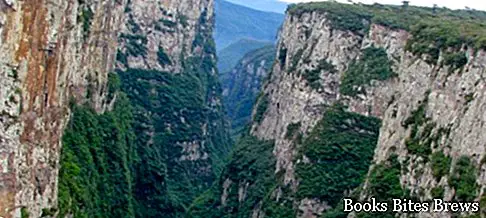Among the narrow spaces of this very hard massif of very ancient times, the water has worked intensely, creating marvelous gardens in the twilight, between caves and long furrows that follow one another regularly on the stone.
Aparados da Serra national park
In the semi-arid interior of the State of Bahia in Brazil, on the banks of Sao Francisco, there is the town of Bom Jesus da Lapa, a name that in Italian means Good Jesus of the Grotto, which has become a traditional pilgrimage site thanks to the limestone massif above it.
This type of limestone consists of massive banks, arranged almost horizontally, which belong to much older sediments.
The limestone, finely recrystallized and therefore very resistant to atmospheric agents, creates a steep relief that dominates the Sao Francisco plain and the city.
Rainwater dissolves a certain amount of atmospheric carbon dioxide, causing corrosion of the limestone and forming soluble calcium bicarbonate.
It is from this particular process that the singular forms of the massif derive, in the past probably a place of worship for the Indians, before becoming a Catholic pilgrimage site.
The water only penetrates along the cracks, because the limestone contained between them is compact and impermeable, a factor that causes natural expansion in narrow abysses a few meters wide and a few tens of meters deep.
The walls of these canyons appear steep, in them solar lighting is almost absent, which is why the humidity present is preserved.
Some plants, such as epiphytes, can cling to limestone and grow.
There are also some species of trees with very developed roots, but generally the bare rock predominates.
The erosion of the rock has created live crests on the peaks, grooves that collect rainwater on the walls and caves at the foot of the massif, in contact with the granite and gneiss substrate.




